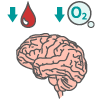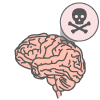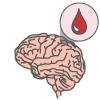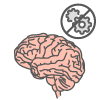What is a birth injury?
 A birth injury describes any type of injury that a baby suffers before, during, or directly after childbirth.
A birth injury describes any type of injury that a baby suffers before, during, or directly after childbirth.
Many babies suffer from minor injuries during delivery that do not need to be treated and often heal on their own in days or weeks. Some birth injuries can lead to more severe complications, resulting in your child having a disability for the rest of their life.
Birth defects vs. birth injuries
There is a significant difference between birth defects and birth injuries. The main differentiator between a birth defect and a birth injury is how they develop.
-
Birth defects
Abnormalities that typically form while a child is still in the womb. According to the Centers for Disease Control and Prevention (CDC), birth defects typically develop within the first three months of pregnancy. Factors such as drug use, family medical history, and untreated infections may increase the risk of birth defects.
-
Birth injuries
Generally happen when the child is being born. Common injuries that occur during childbirth include physical head trauma and brain bleeds.
Birth injury causes
Birth injuries can be a result of brain damage caused by several risk factors and conditions during childbirth. Each cause is distinct and can lead to different types of birth injuries.
Delayed birth is one of the most common causes of birth injuries. Labors that last over 18 hours are considered delayed births. As time goes on during labor, pressure increases on the infant’s brain. The compression can lead to fetal distress and high blood pressure, resulting in strokes and other cardiovascular issues.
Oxygen deprivation is another cause of a wide range of birth injuries. This can be caused by a prolapsed umbilical cord, or from underdeveloped lungs in a premature infant. Most brain-related birth injuries are caused by oxygen deprivation.
Certain medications, viral infections, and bacterial infections in the mother or infant can also lead to complications resulting in birth injuries.
Types of brain damage that cause birth injuries
Birth injuries can occur from damage to the developing brain before, during, or after birth.
There are four basic types of brain damage that result from trauma during childbirth. These types of brain damage can result in birth injuries.
 Hypoxic ischemic encephalopathy (HIE)
Hypoxic ischemic encephalopathy (HIE)Classified as brain damage caused by decreased blood and oxygen levels to the brain. HIE leads to destruction of brain cells and tissue in the motor cortex, leading to cerebral palsy and periventricular leukomalacia. HIE is the most common type of brain damage during childbirth.
 Periventricular leukomalacia (PVL)
Periventricular leukomalacia (PVL)Occurs when white matter in the brain dies, resulting in loss of brain tissue. White matter is made of nerve fibers that relay signals for motor function and can affect the brain’s ability to learn and function. PVL is caused by lack of blood flow to the periventricular part of the brain and can co-occur with bleeding. Placental failure and infection may cause PVL.
 Intracranial hemorrhage
Intracranial hemorrhageClassified as bleeding in the brain. The most common cause of intracranial hemorrhaging is fetal stroke from blocked or damaged blood vessels. High blood pressure, placenta complications, and reproductive system infections in the mother may lead to an intracranial hemorrhage. This is most common in premature infants.
 Cerebral dysgenesis
Cerebral dysgenesisDescribes abnormal development of the fetal brain. This generally occurs during pregnancy when the fetal brain is forming. Direct injury to the baby’s head during or shortly after delivery can also cause cerebral dysgenesis. Infections in the fetal brian can mutate genes responsible for motor function development.
Risk factors
There are several conditions that can lead to a birth injury. Risk factors that are prevalent in maternal and infant conditions are associated with a higher risk of birth injury.
It is very important to understand these risks so they can be identified and avoided during pregnancy.
Maternal risk factors include:
- Certain pelvis shapes or sizes: When the mother’s pelvis shape is not conductive to a safe birth, there is potential for the child to struggle or twist in the birth canal, resulting in loss of oxygen flow (asphyxia)
- Difficult labor or delivery (dystocia): May be caused by an awkwardly positioned fetus or by a cervix that is unable to expand. Both of these conditions can make it difficult for the child to exit the birth canal
- Prolonged labor: Generally associated with a higher risk of birth injuries due to difficulty with fetus exiting the birth canal
Infant risk factors include:
- Babies weighing over 8 pounds and 13 ounces (macrosomia): Heavier infants are at a higher risk of a difficult delivery resulting in birth injuries
- Babies born before the 37th week of pregnancy (prematurity): Premature births have a higher risk for birth injury because the child’s muscles and nervous system have not fully developed
- Abnormal fetal position: Infants born in head-up, buttocks-first, or breech positions are more likely to suffer a birth injury
Another common risk factor for birth injury is physical injury to the child during delivery. Physical injuries can occur during the use of forceps or vacuum extractors during delivery.
Medical negligence
Medical negligence occurs when medical professionals do not meet the standard of care expected of them, which can result in serious complications during the birthing process.
Medical negligence can occur before, during, or after birth. Healthcare professionals are trained to understand the birthing process and to monitor any risk factors that may result in birth injuries.
Some medical personnel may be negligent in the medical care they provide, resulting in injuries to the child and/or mother.
Forms of medical negligence during childbirth include:
- Failure to act quickly in dangerous situations
- Failure to diagnose any apparent health conditions in the mother or baby
- Failure to monitor the mother or baby after childbirth
- Misuse of birthing tools such as forceps or vacuum extractor
- Use of unnecessary force during childbirth
Complications caused by these forms of medical malpractice can result in long-term birth injuries that can affect a child for their entire lifetime.
Types of birth injuries
Different risk factors and types of brain damage can lead to different types of birth injuries. Each type of birth injury can have different causes and symptoms depending on each case.
Cerebral palsy
Cerebral palsy is a group of disorders that affect the brain’s control over muscles and the nervous system. Cerebral palsy is caused by brain damage shortly before or during birth.
This brain injury affects different areas of the body and does not improve or worsen over time, but may cause additional health complications.
Cerebral palsy has no cure. Therapy, medication, and surgery can be used to improve your child’s quality of life. Children may be able to live independently or may require lifelong care depending on the severity of the condition.
Erb’s palsy
Erb’s palsy is a brachial plexus injury caused by nerve damage from shoulder dystocia.
The pulling on the child during a difficult delivery can damage the network of nerves that sends signals from the spine to the shoulders, arms, and hands. This results in improper use of the affected limb.
babies are born with Erb's palsy
According to the American Academy of Orthopedic Surgeons
Intrauterine fetal demise
Intrauterine fetal demise (IUFD) describes when a child dies in utero after the 20th week of pregnancy in the second trimester.
Most doctors consider a death to be an IUFD if it occurred after 20 weeks of gestation. This is as opposed to a miscarriage, which happens before the 20th week.
Signs of IUFD include not feeling the fetus moving or kicking, pain in the abdomen, infection or high fever, and vaginal bleeding.
pregnancies end in IUFDs
According to the National Vital Statistics Report from 2006
Newborn jaundice
Jaundice is a very common condition found in about 60% of newborn babies. Jaundice is caused by a buildup of bilirubin. This substance can yellow the baby’s skin and the whites of their eyes.
Most cases of jaundice are harmless and easily treated with light therapy to break down and remove bilirubin from the baby’s blood. Severe cases may require a blood transfusion.
Children may be at a higher risk for jaundice if they are born before 38 weeks, suffer from severe bruising during birth, have a different blood type than the mother, or have trouble breastfeeding.
Kernicterus
Kernicterus is a very rare form of brain damage caused by untreated severe newborn jaundice. The condition is caused by high levels of bilirubin in the blood, leading to toxic levels in the brain.
Kernicterus only affects about 1 in 44,000 newborns in developed countries because jaundice is usually treated before it develops into kernicterus.
Once treated, kernicterus may cause very mild neurological issues and motor skills.
Newborn cephalohematoma
Newborn cephalohematoma occurs from a buildup of ruptured blood vessels in the tissue that covers the skull. Many cases of this type of birth injury are able to heal on their own.
If a hematoma is left untreated, the pooled blood will put excess pressure on brain tissue, leading to fatal complications or lifelong disability.
According to experts from the University at Buffalo and the Thomas Jefferson University Hospital, infant hematomas occur in 0.4% to 2.5% of all live births.
Spinal cord injury
Spinal cord injuries disrupt the connection of nerves between the brain and the rest of the body. This birth injury is caused by trauma to a specific area on the spinal cord. The severity of the injury can range from mild bruising to complete spinal tears.
Injuries to the spinal cord are often a result of medical malpractice. Improper use of forceps or vacuum extractors where the doctor pulls or twists a compressed baby can cause a spinal cord injury.
Approximately 17,500 people experience a spinal cord injury each year, but only 5% of these affect children.
Vacuum extraction injury
Vacuum extraction injuries occur from the misuse of a vacuum extractor. The use of assisted delivery devices such as a vacuum extractor occurs in about 5% of all births.
Injuries from a vacuum extractor can include scalp wounds, skull fractures, internal bleeding, brain damage, and brachial plexus nerve damage that can result in Erb’s palsy.
Some of these conditions are able to heal on their own without medical intervention, while some serious complications can result in permanent damage to both the mother and baby.
Signs and symptoms of birth injuries
Most signs and symptoms of birth injuries do not present themselves directly after childbirth. Some symptoms of birth injuries may not show for 1-2 years into a child’s life.
While not all of the following symptoms may be a conclusive indication that your child sustained a birth injury, they can serve as an important sign that some form of damage may have taken place during childbirth.
These symptoms may be a warning sign that your child has developed a condition related to brain or nerve damage, such as cerebral palsy. It is very important to monitor your child for any complications.
Immediate symptoms of a birth injury include:
- Arched back while crying
- Difficult suckling, eating, or swallowing
- Excessive drooling
- Hand curled into claw-like shape
- High-pitched crying
- Low heart rate
- Low oxygen levels
- Loose or stiff muscles
- Sensitivity to light
- Weak reflexes
Some of the most important symptoms to keep an eye out for after delivery is seizures and skull fractures. These can pose a serious threat to your child’s health and can result in permanent brain damage if not monitored and treated promptly.
As your child gets older, symptoms of a birth injury usually present themselves when your child misses important developmental milestones or shows physical signs of brain or nerve damage.
Symptoms of a birth injury for 12 months of age and older include:
- Blindness, deafness, or muteness
- Delay in speech development and comprehension
- Developmental disabilities such as autism or epilepsy
- Difficulty eating, drinking, or grasping utensils
- Difficulty walking or crawling
- Inability to sit, stand, walk, or crawl without assistance
- Lack of muscle control or spasms (spasticity)
- Loss of bodily movements (ataxia)
- Intellectual disabilities such as low memory retention
- Poor hand-mouth and hand-eye coordination
- Stiff muscles (hypertonia)
- Tremors or shakiness
If your child exhibits any of the symptoms above, you should consult a doctor to get a diagnosis for your child’s condition.
Birth injury diagnosis


In order to get a diagnosis for your child’s condition, your doctor will run a series of diagnostic tests to examine your child’s overall health.
A typical diagnostic test done at birth to evaluate any sign of birth injuries is an Apgar test. Doctors will perform an Apgar test to monitor and measure the child’s vital signs. The test can analyze heart rate, muscle tone, reflexes, breath, and skin tone. A high Apgar score indicates a healthy child.
Doctors will test the oxygen and carbon dioxide levels in the umbilical cord blood through an umbilical cord blood gas analysis to determine if the child had suffered from HIE or health problems during delivery. The umbilical cord contains blood vessels filled with oxygen-rich blood and carbon dioxide.
Neuroimaging tests such as an MRI (magnetic resonance imaging) or CT (computer tomography) scan can analyze the brain for any signs of HIE or other types of brain damage that may cause symptoms of a birth injury.
Once all the required diagnostic testing results are in, the doctor will be able to diagnose your child and establish a treatment plan.
Birth injury prognosis
Once a doctor has diagnosed your child’s birth injury, they are then able to give a prognosis. A prognosis is the projected outcome of a condition.
Birth injuries come in many forms, and the prognosis for a child with a birth injury can vary depending on several factors.
Your child’s prognosis may depend on the type of birth injury diagnosis and the severity of the injury.
Birth injury prognosis statistics:
According to a 2012 study conducted by the Cerebral Palsy Alliance Research Institute and the University of Notre Dame School of Medicine in Sydney, Australia, the following statistics were gathered based on a sample of children with cerebral palsy.
- 75% experienced pain due to their condition.
- 50% had an intellectual disability.
- 33% could not walk.
- 25% had epilepsy.
- 33% had a hip displacement.
- 25% of children with cerebral palsy could not talk.
- 25% had some sort of behavior disorder.
- 25% had issues controlling their bladder.
- 20% of children had a sleep disorder.
- 20% of children experienced problems with drooling.
- 10% were blind.
- One in every 15 children with cerebral palsy required tube feeding.
- One in every 25 children were deaf.
Birth injury treatment
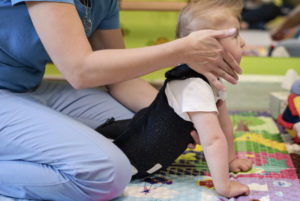

Therapy is a common form of birth injury treatment. Physical and aquatic therapy is designed to help children who suffer from issues with muscle tone, mobility, and coordination. These therapies are designed to build and loosen muscles.
Occupational therapy
Occupational therapy can help children that struggle with daily tasks such as eating, bathing, reading, writing, brushing their teeth, and getting dressed. Speech therapy can assist children that have developmental delays in their speech.
Medications
Medications can also be used to treat pain and other conditions such as swelling, spasticity, incontinence, and seizures.
Assistive devices
Assistive devices may be needed if a child has difficulties with physical movement. Some children require crutches, wheelchairs, or leg braces. Other adaptive equipment for more severe cases of disabilities include breathing support or catheters.
Surgery
Surgery may be required for some situations where therapy, medication, and adaptive equipment do not work. Blood clots, brain bleeds, and seizures may require surgery.
Some types of birth injuries require specialized treatment that may not apply to other types of injuries. Some examples of this include light therapy for jaundice and kernicterus, and Burr Hole surgery for infant hematomas.
Birth injury prevention
Although there is no way to guarantee prevention of birth injuries, there are several steps parents can take to lower the risk for their unborn child.
Regular checkups during pregnancy
Getting care from an experienced obstetrician can reduce the risk of a birth injury. Medical professionals can monitor the health of the mother and fetus throughout pregnancy to prevent any childbirth complications.
Mothers should get regular checkups during pregnancy to ensure there are no complications for the mother or the baby and manage any existing health issues.
Take supplements
Taking folic acid supplements can also reduce the risk of neural tube defects in the child that can lead to serious birth injuries such as spina bifida and anencephaly.
Be informed
Doctors should also inform mothers about any possible risk factors that may cause complications for the child. Doctors should analyze genetic history and other risk factors to ensure the delivery of a healthy baby.
Take legal action against preventable birth injuries
Unfortunately, medical malpractice is often the cause of preventable birth injuries. Careless and negligent mistakes made by medical personnel during childbirth can leave many children with lifelong disabilities.
Working with an experienced birth injury attorney can help your family pursue legal justice and hold the hospital that delivered your child accountable for their negligent care.
Many families have proven that their child’s birth injury was in fact preventable, and were able to receive financial compensation to help pay for their child’s lifelong medical costs.
If you feel the health care team that delivered your child was negligent in their care, your family may be entitled to financial compensation. Get a free case review today to learn more about pursuing legal action.

